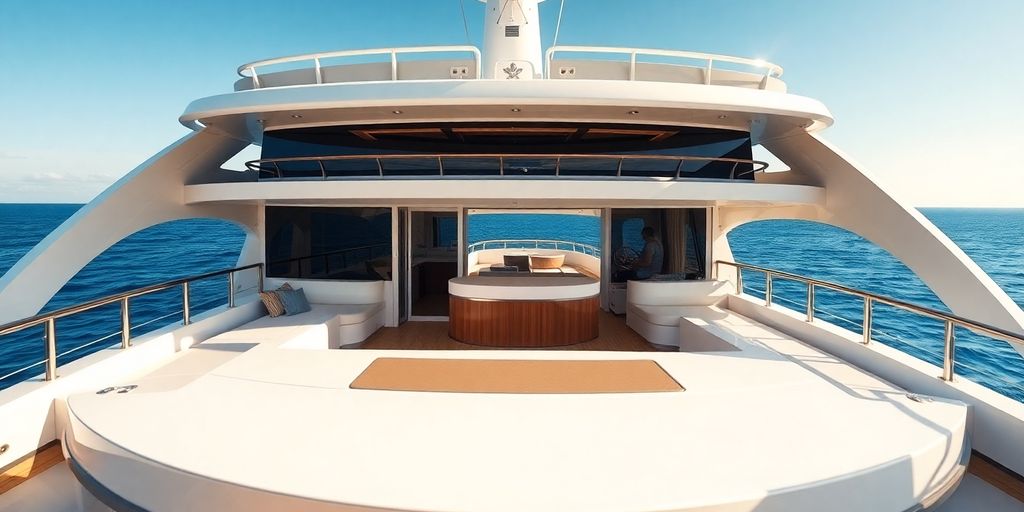So, you’re curious about what makes a yacht tick? It’s more than just a fancy boat; it’s a complex machine built for comfort and adventure on the water. Whether you’re dreaming of owning one or just admire them from the shore, understanding the basic parts of a yacht is pretty interesting. Let’s break down what goes into these amazing vessels, from the part that keeps them afloat to how they actually move.
Key Takeaways
- The hull is the main body of the yacht, keeping it afloat and influencing how it moves.
- Propulsion systems, like engines and propellers, are what make the yacht go.
- The deck and superstructure are the parts you see above the water, offering space and housing important areas like the bridge.
- Navigation and electronic systems help the crew steer and communicate.
- For sailing yachts, rigging and sails are key to catching the wind.
The Hull: Foundation Of Your Yacht

The hull is pretty much the main body of the yacht, the part that actually sits in the water. Think of it as the boat’s skeleton and skin all rolled into one. It’s what keeps the whole thing afloat and stable. The shape and size of the hull have a massive impact on how the yacht performs – how fast it can go, how smoothly it rides through waves, and how easily it turns. It’s not just a big box; the design is really thought out.
Understanding The Hull's Role
The hull’s primary job is to provide buoyancy, meaning it displaces enough water to support the yacht’s weight. Beyond just floating, it’s designed to handle the forces of the sea, like waves and wind, without breaking apart. It also dictates the yacht’s stability; a wider, flatter hull might be more stable at rest but slower, while a narrower, deeper hull might cut through waves better but could be less stable. It’s a balancing act that naval architects spend a lot of time figuring out. The hull also houses many of the yacht’s internal systems and provides space for living quarters.
Hull Materials And Construction
When it comes to what hulls are made of, there are a few common choices. Fiberglass is super popular because it’s strong, relatively easy to repair, and can be molded into complex shapes. Steel is used for larger, tougher yachts, offering great durability but requiring more maintenance to prevent rust. Aluminum is lighter than steel and also resists corrosion, making it a good option for performance-oriented yachts. The way the hull is built, the actual construction method, also matters a lot for its strength and longevity. Yacht construction is a sophisticated, multi-stage endeavor that integrates yacht design, naval architecture, marine engineering, and premium craftsmanship to produce exceptional vessels. Understanding yacht construction gives you a better idea of the work involved.
Here’s a quick look at common hull materials:
| Material | Pros |
|---|---|
| Fiberglass | Durable, easy to repair, versatile |
| Steel | Very strong, good for large yachts |
| Aluminum | Lightweight, corrosion-resistant |
| Wood | Traditional, aesthetically pleasing |
Hull Shapes And Performance
Hull shapes are really interesting because they directly affect how the yacht moves. You’ve got different types:
- Displacement Hulls: These are like the workhorses. They push water aside as they move and are generally slower but very fuel-efficient and comfortable for long trips. Think of a big cruise ship – it has a displacement hull.
- Planing Hulls: These are designed to lift up and skim over the water’s surface at higher speeds. They need more power to get going but can be much faster. Most speedboats and many motor yachts have planing hulls.
- Semi-Displacement Hulls: A bit of a mix, these can operate efficiently at displacement speeds but can also lift slightly and achieve higher speeds than a full displacement hull.
- Catamarans: These have two parallel hulls. They offer a lot of stability and deck space, and can be quite fast, especially in lighter winds for sailing versions.
The choice of hull shape is a compromise. Designers balance speed, fuel economy, stability, and the type of water the yacht will typically be used in. It’s all about matching the hull to the intended purpose of the vessel.
So, the hull isn’t just a container; it’s a carefully engineered part that dictates so much about the yacht’s behavior on the water.
Propulsion Systems: Powering Your Yacht
Every yacht needs a way to move, and that’s where the propulsion system comes in. Think of it as the yacht’s engine room, the place where all the power is generated to get you from point A to point B. It’s not just about going fast; it’s about control, efficiency, and reliability out on the water. Whether you’re cruising the coast or crossing an ocean, the heart of your yacht’s movement lies within this complex, yet vital, system. Understanding how these parts work together is key to a smooth and enjoyable journey.
Engine Types and Placement
Modern yachts utilize a variety of engine types, each with its own set of advantages. The most common are diesel engines, known for their durability and fuel efficiency, making them a popular choice for longer voyages. Gasoline engines are also found, often in smaller or faster vessels, offering good power-to-weight ratios. Increasingly, we’re seeing hybrid and even fully electric propulsion systems emerge, driven by a desire for quieter operation and reduced environmental impact. The placement of these engines also matters. Inboard engines are typically housed within the hull, offering a lower center of gravity and often quieter operation, while outboard motors are mounted on the transom, providing easier maintenance and more flexibility in terms of space.
Propellers and Thrust Generation
Propellers are the workhorses that actually push the yacht through the water. These rotating blades are designed to convert the rotational force from the engine into forward or backward thrust. The size, shape, and number of blades on a propeller are all carefully engineered to match the specific hull design and intended performance of the yacht. A well-matched propeller can significantly improve efficiency and speed. Some larger yachts might also employ water jets, which suck water in and expel it at high speed, offering excellent maneuverability, especially at lower speeds.
Steering Mechanisms and Rudders
Steering is how you direct your yacht, and it’s usually managed by a rudder or, in some cases, by vectoring the thrust from the propellers or water jets. The rudder is a flat, submerged surface, typically located at the stern, that pivots to change the direction of water flow, thereby turning the yacht. It’s controlled by the helm, usually a steering wheel or joystick, which is connected via a mechanical or hydraulic linkage. The effectiveness of the rudder depends on the flow of water past it, which is why steering is less responsive at very slow speeds. For enhanced maneuverability, especially in tight spaces like marinas, many yachts are also equipped with bow or stern thrusters, which are small, powerful propellers that push the yacht sideways.
The entire propulsion system, from the engine’s roar to the subtle turn of the rudder, is a symphony of engineering designed to move a substantial vessel with grace and power. It’s a testament to how we’ve learned to harness energy to explore the world’s waterways.
Deck And Superstructure: Above The Waterline
The deck and superstructure are what you see when you first approach a yacht, the parts that sit above the water. Think of the deck as the main floor of your floating home. It’s where you’ll spend a lot of time, whether you’re soaking up the sun, enjoying a meal al fresco, or just taking in the view. Different parts of the deck have different jobs. The foredeck, up front, often holds the anchor gear. The side decks are for moving around the boat safely, and the aft deck, at the back, is usually set up for relaxing or dining.
Rising above the deck is the superstructure. This is like the upper levels of the yacht, housing the main living areas, the helm station (where the boat is steered), and sleeping quarters. Its design really shapes the yacht’s look and how usable the interior space is. A lot of thought goes into making sure the superstructure provides good views from inside and keeps the weather out, all while looking good.
Deck Layout and Functionality
The layout of a yacht’s deck is all about making the most of the space. You’ll find areas designed for different activities. Some decks have open spaces for lounging, while others might have more defined areas like a cockpit with seating and controls for steering. The goal is to balance open areas for enjoying the sea air with functional spaces for moving about and operating the vessel. It’s a bit like designing a house, but on the water.
Superstructure Design and Purpose
The superstructure is more than just a roof; it’s the enclosed part of the yacht. It contains the salon, cabins, and the bridge. The design here is a mix of aesthetics and practicality. Architects and designers work to maximize natural light inside and provide great visibility from the helm. The shape and size of the superstructure greatly influence the yacht’s overall profile and how much living space is available. It’s where the comfort and luxury of the yacht really come into play, offering shelter and a place to relax away from the elements. You can see some amazing examples of modern superstructure design when looking at new yacht construction.
Key Deck Features Like Swim Platforms
Many yachts feature a swim platform at the stern. This is a fantastic addition, essentially a built-in dock that makes getting in and out of the water super easy. It’s perfect for swimming, snorkeling, or just enjoying the water. Some platforms are fixed, while others can be lowered or raised, making them even more versatile for launching tenders or water toys. It really extends your connection to the sea, turning the yacht into a base for aquatic fun.
Navigation And Electronics: Charting Your Course
Keeping your yacht on course and aware of your surroundings is all about the right gear. Modern yachts are packed with tech to help you get where you’re going safely. It’s not just about knowing where you are, but also about seeing what’s around you and communicating effectively. This technology makes long trips and navigating tricky waters much more manageable.
Essential Navigation Instruments
When you’re out on the water, knowing your position and the best way to get somewhere is key. You’ve got a few main tools for this:
- GPS (Global Positioning System): This is your basic locator. It tells you latitude and longitude, speed, and direction. Most modern systems are pretty accurate, giving you a clear idea of where you are on the water.
- Chartplotters: Think of these as a digital map that shows your GPS position. They display electronic charts, and as you move, your boat icon moves along the chart. It’s way easier than wrestling with paper charts, especially in rough weather.
- Depth Sounders (or Fishfinders): These gadgets tell you how deep the water is beneath your hull. This is super important for avoiding shallows and knowing if you’ve got enough water to pass.
- Radar: Radar is like your eyes in fog or at night. It sends out radio waves that bounce off objects like other boats, land, or buoys, showing them as blips on a screen. It’s a big help for avoiding collisions.
Communication Systems Onboard
Staying in touch is vital, whether it’s for coordinating with other boats, getting weather updates, or calling for help if something goes wrong. Here’s what most yachts have:
- VHF Radio: This is your standard marine radio. You can talk to other boats, marinas, and coast guard stations. It’s also used for receiving weather broadcasts. Knowing how to use the different channels and distress calls is a must.
- AIS (Automatic Identification System): This system broadcasts your boat’s identity, position, and course to other AIS-equipped vessels and shore stations. It also receives similar information from others, making it easier to see and avoid potential conflicts, especially in busy areas. It’s a great complement to radar.
- Satellite Phone: For those really far-off trips where cell service is non-existent, a satellite phone is your lifeline. It lets you make calls and send messages from almost anywhere on the planet.
Understanding the different communication protocols, like when to use a Mayday versus a Pan-Pan call, is as important as having the equipment itself. Clear communication can save lives.
Autopilot And Advanced Electronics
Once you’ve got your position and communication sorted, you can look at making the journey smoother. Autopilots are a game-changer for longer trips. They can steer the boat to a specific compass heading or even follow a pre-programmed GPS route, letting the crew relax a bit. Many modern systems use data from your GPS, compass, and even wind instruments to keep you on track. The integration of these systems, often using protocols like NMEA 2000, allows them to share information and work together more effectively. This kind of networked electronics setup means your chartplotter can talk to your autopilot, and your radar can feed information into your navigation display, all contributing to a safer and more efficient voyage. You can find more details on how these systems communicate in this guide to marine electronics standards.
Rigging And Sails: Harnessing The Wind
For sailing yachts, the rigging and sails are the heart of how the boat moves. Think of the mast as the backbone, standing tall and holding everything up. Then you have the rigging, which is basically all the wires and ropes that support the mast and control the sails. It’s a whole system working together to catch the wind and push the boat forward. Without it, you’re just floating.
Mast And Supporting Rigging
The mast is the tall pole that holds up the sails. It needs to be strong because the wind pushes hard on the sails, and that force goes right into the mast. To keep the mast from falling over, there are wires called shrouds that go from the mast down to the sides of the boat, and stays that go from the mast forward and backward. These wires, collectively known as the standing rigging, give the mast the stability it needs. It’s pretty amazing how these simple wires can handle so much force. You can find more about the basic parts of a vessel on pages discussing ship terminology.
Types Of Sails And Their Functions
Sails are what actually catch the wind. The main sail, usually the biggest one, is attached to the mast and the boom (that’s the horizontal pole at the bottom). Then there’s the jib, which is a sail at the front of the boat. Different sails are used for different wind directions. For example, a spinnaker is a big, balloon-like sail used when the wind is coming from behind you, helping the boat go faster. Each sail has a specific job to do to get the most out of the wind.
Sail Control And Adjustment Systems
Controlling the sails is how you steer the boat using the wind. You use ropes, called sheets, to pull the sails in or let them out. When you want to go upwind, you pull the sails in tight. When you’re going downwind, you let them out a lot. There are also systems to adjust the angle of the sails. It’s all about trimming the sails just right to get the best speed and direction. It’s a constant process of tweaking and adjusting as the wind changes.
Electrical And Plumbing Systems: Comfort And Convenience

Think of your yacht’s electrical and plumbing systems as its life support. They’re what turn a floating vessel into a comfortable place to live, even when you’re miles from shore. Without them, you’d be roughing it pretty hard. These systems handle everything from powering your lights and appliances to providing fresh water and taking care of waste. Keeping them in good shape means you can actually relax and enjoy your time on the water.
Onboard Power Generation
Powering everything on a yacht is a big job. Most boats get their juice from a combination of sources. You’ve got your main engine alternator, which charges up the batteries when the engine is running. Then there are usually dedicated generators, either diesel or gas, that can power the whole boat when you’re anchored or just not running the main engine. And of course, the batteries themselves are key. They store the power and provide it when nothing else is running. The battery is the core of a boat’s 12-volt electrical system, generating voltage through a chemical reaction to power onboard equipment. It’s pretty important to keep an eye on your battery levels and make sure they’re healthy. You’ll often see different types of batteries, like lead-acid or lithium-ion, each with its own pros and cons regarding cost, weight, and lifespan. A good electrical system also includes a shore power connection, so you can plug into marina power when available, and a robust inverter/charger system to manage the flow of electricity.
Water Systems and Waste Management
Fresh water is a big deal when you’re out on the water. Yachts typically have onboard tanks that store fresh water, which is then pumped to sinks, showers, and even the galley. The size of these tanks varies a lot depending on the boat’s size and intended use. Some larger yachts might even have water makers that can turn saltwater into fresh water, which is pretty neat if you plan on doing long voyages. Waste management is also a big part of the plumbing. Most boats have holding tanks for sewage, which need to be pumped out at designated facilities. There are also greywater systems for sinks and showers, which handle wastewater that doesn’t contain sewage. Proper maintenance of these systems is key to avoiding unpleasant odors and environmental issues. It’s also important to know the regulations in different areas regarding waste discharge.
Climate Control and Appliances
Keeping comfortable on a yacht often comes down to climate control. This usually means air conditioning and heating systems. Air conditioning units can be quite power-hungry, so they’re typically run off the generator or shore power. Heating might come from the same systems or dedicated heaters. Beyond climate control, you’ll find various appliances that make life easier. Refrigerators and freezers are standard, keeping your food fresh. Galley appliances like microwaves, ovens, and stovetops are common too. Some larger yachts even have dishwashers or ice makers. All these systems rely on the electrical and plumbing infrastructure to function, so their reliability is directly tied to how well those core systems are maintained. It’s all interconnected, really.
Safety Equipment: Ensuring Peace Of Mind
When you’re out on the water, having the right safety gear isn’t just a good idea, it’s absolutely necessary. It’s all about making sure everyone stays safe, no matter what happens. Think of it like this: you wouldn’t go on a long drive without checking your tires, right? Same idea here, but with higher stakes.
Life Saving Appliances
This category covers the gear that directly helps keep people afloat and safe in an emergency. We’re talking about life jackets, of course, but also things like life rafts. Everyone on board needs a properly fitting life jacket, and they should be easy to grab. Life rafts are for more serious situations, designed to keep a group safe if the boat itself is no longer usable. It’s important to check these items regularly to make sure they’re in good condition and haven’t expired. You can find more details on required gear for Canadian waters at Transport Canada.
Fire Suppression Systems
Fires can break out on boats, and when they do, they can spread fast. That’s why having reliable fire extinguishers is a must. You’ll want to have a few of them, placed in accessible spots, and know how to use them. Some larger yachts might also have built-in systems that can automatically put out a fire in the engine room or other key areas. Keeping these systems maintained is key.
Emergency Signaling Devices
If you run into trouble and need help, you need a way to let people know. This is where signaling devices come in. We’re talking about flares, which come in different types for different situations, and also things like distress flags or even an Emergency Position-Indicating Radio Beacon (EPIRB). An EPIRB is pretty advanced; it sends out a signal with your location to rescue authorities if you’re in real trouble. Knowing which signal to use and when is part of being prepared.
Being prepared means having the right equipment and knowing how to use it. It’s not about expecting the worst, but about being ready for anything so you can relax and enjoy your time on the water.
Wrapping Up Our Yacht Exploration
So, we’ve looked at a lot of different parts that make up a yacht, from the big stuff like the hull and engine to the smaller bits that keep things running smoothly. It’s pretty amazing how all these pieces work together, right? Whether you’re thinking about buying a yacht or just enjoy learning about them, knowing these basics really helps you appreciate these boats more. It’s not just about luxury; it’s about a whole lot of engineering and design. Now you’ve got a better idea of what goes into making these vessels float and move, so you can enjoy the water with a bit more know-how.
Frequently Asked Questions
What is the hull of a yacht and why is it important?
The hull is like the boat’s body. It’s what keeps the yacht floating and stable in the water. Different hull shapes help the yacht move faster or be steadier.
How does a yacht move through the water?
The propulsion system is what makes the yacht move. It usually includes an engine and propellers that push the water to move the boat forward. Rudders help steer it.
What's the difference between the deck and the superstructure?
The deck is the flat part on top where people walk around. The superstructure is the part above the deck, like the cabin or where the captain steers. They are designed for both walking and living on the boat.
What kind of electronics does a yacht use for navigation?
Navigation tools like GPS and radar help the captain know where the yacht is and where it’s going. Electronics also help with communication and sometimes steering the boat automatically.
What are rigging and sails on a sailboat?
For sailboats, rigging includes the tall mast and the ropes that hold and control the sails. The sails catch the wind to make the boat move.
What do the electrical and plumbing systems do on a yacht?
These systems provide power for lights, appliances, and air conditioning. Plumbing systems bring in fresh water for use and take away used water and waste, making life on the yacht comfortable.



